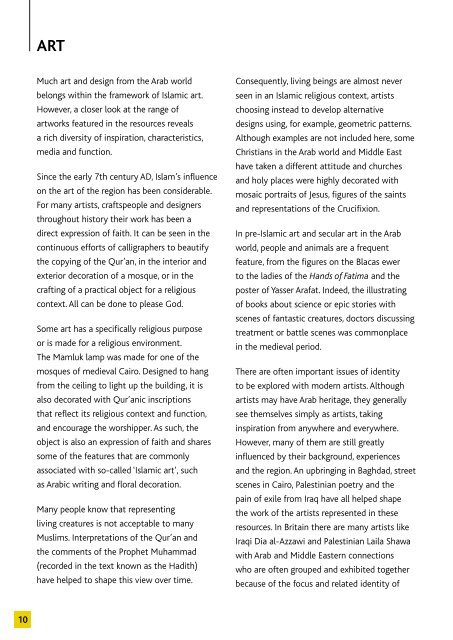Create successful ePaper yourself
Turn your PDF publications into a flip-book with our unique Google optimized e-Paper software.
10<br />
ART<br />
Much art and design from the Arab world<br />
belongs within the framework of Islamic art.<br />
However, a closer look at the range of<br />
artworks featured in the resources reveals<br />
a rich diversity of inspiration, characteristics,<br />
media and function.<br />
Since the early 7th century AD, Islam’s influence<br />
on the art of the region has been considerable.<br />
For many artists, craftspeople and designers<br />
throughout history their work has been a<br />
direct expression of faith. It can be seen in the<br />
continuous efforts of calligraphers to beautify<br />
the copying of the Qur’an, in the interior and<br />
exterior decoration of a mosque, or in the<br />
crafting of a practical object for a religious<br />
context. All can be done to please God.<br />
Some art has a specifically religious purpose<br />
or is made for a religious environment.<br />
The Mamluk lamp was made for one of the<br />
mosques of medieval Cairo. Designed to hang<br />
from the ceiling to light up the building, it is<br />
also decorated with Qur’anic inscriptions<br />
that reflect its religious context and function,<br />
and encourage the worshipper. As such, the<br />
object is also an expression of faith and shares<br />
some of the features that are commonly<br />
associated with so-called ‘Islamic art’, such<br />
as Arabic writing and floral decoration.<br />
Many people know that representing<br />
living creatures is not acceptable to many<br />
Muslims. Interpretations of the Qur’an and<br />
the comments of the Prophet Muhammad<br />
(recorded in the text known as the Hadith)<br />
have helped to shape this view over time.<br />
Consequently, living beings are almost never<br />
seen in an Islamic religious context, artists<br />
choosing instead to develop alternative<br />
designs using, for example, geometric patterns.<br />
Although examples are not included here, some<br />
Christians in the Arab world and Middle East<br />
have taken a different attitude and churches<br />
and holy places were highly decorated with<br />
mosaic portraits of Jesus, figures of the saints<br />
and representations of the Crucifixion.<br />
In pre-Islamic art and secular art in the Arab<br />
world, people and animals are a frequent<br />
feature, from the figures on the Blacas ewer<br />
to the ladies of the Hands of Fatima and the<br />
poster of Yasser Arafat. Indeed, the illustrating<br />
of books about science or epic stories with<br />
scenes of fantastic creatures, doctors discussing<br />
treatment or battle scenes was commonplace<br />
in the medieval period.<br />
There are often important issues of identity<br />
to be explored with modern artists. Although<br />
artists may have Arab heritage, they generally<br />
see themselves simply as artists, taking<br />
inspiration from anywhere and everywhere.<br />
However, many of them are still greatly<br />
influenced by their background, experiences<br />
and the region. An upbringing in Baghdad, street<br />
scenes in Cairo, Palestinian poetry and the<br />
pain of exile from Iraq have all helped shape<br />
the work of the artists represented in these<br />
resources. In Britain there are many artists like<br />
Iraqi Dia al-Azzawi and Palestinian Laila Shawa<br />
with Arab and Middle Eastern connections<br />
who are often grouped and exhibited together<br />
because of the focus and related identity of<br />
their work. This can help us to understand<br />
their character and motivation, as long as we<br />
avoid the temptation to label artists solely<br />
according to culture.<br />
Where traditional artists and craftspeople<br />
often used glass, ceramics and metal,<br />
contemporary artists are constantly<br />
experimenting and pushing the boundaries<br />
of media using stencils, foam board, acrylic<br />
paint, canvas, photographs and even used<br />
newspapers.<br />
Over time, artists, craftspeople and<br />
designers have often combined the skills of<br />
calligrapher, illustrator and sculptor, in their<br />
work. Today, the modern Arab artist may<br />
make art specifically to highlight a political<br />
issue, to sell to private collectors or museums,<br />
or simply because they feel inspired, and this<br />
is something that all artists share whatever<br />
their heritage.<br />
Sabah Naim, Cairo Faces. Painted photograph on canvas and newspaper.<br />
Egypt, AD 2005. © Sabah Naim.<br />
ACTIVITIES ON ART<br />
CARD NUMBERS: 6, 7, 8, 9, 10<br />
See page 22 for Themes Matrix.<br />
1. Brainstorm with the class on art and design<br />
in the Arab and Islamic worlds.<br />
2. Divide the class and distribute the cards.<br />
Ask the students to discuss the object they<br />
see. They should then describe to the class<br />
what characteristics their object has and why<br />
these might relate to the Arab world.<br />
3. Ask your students to sketch their object<br />
and use the text to help them annotate it,<br />
considering why their object or structure<br />
was produced and what inspired the artist<br />
or designer. They could supplement their<br />
comments following further research.<br />
4. Discuss the range of media and materials,<br />
techniques and processes that have been used<br />
to create the objects. Ask the students to<br />
explain whether they can think of particular<br />
reasons why these were used.<br />
5. Ask the students to develop a piece of art<br />
in response to this work on the Arab world.<br />
Before starting, they could select at least five<br />
objects from the pack including contemporary,<br />
historical, personal and cultural examples<br />
that they are going to work from. They could<br />
sketch and annotate, explaining why they<br />
are using the images and how they represent<br />
the Arab world. Further research could be<br />
done at this point.<br />
11

















